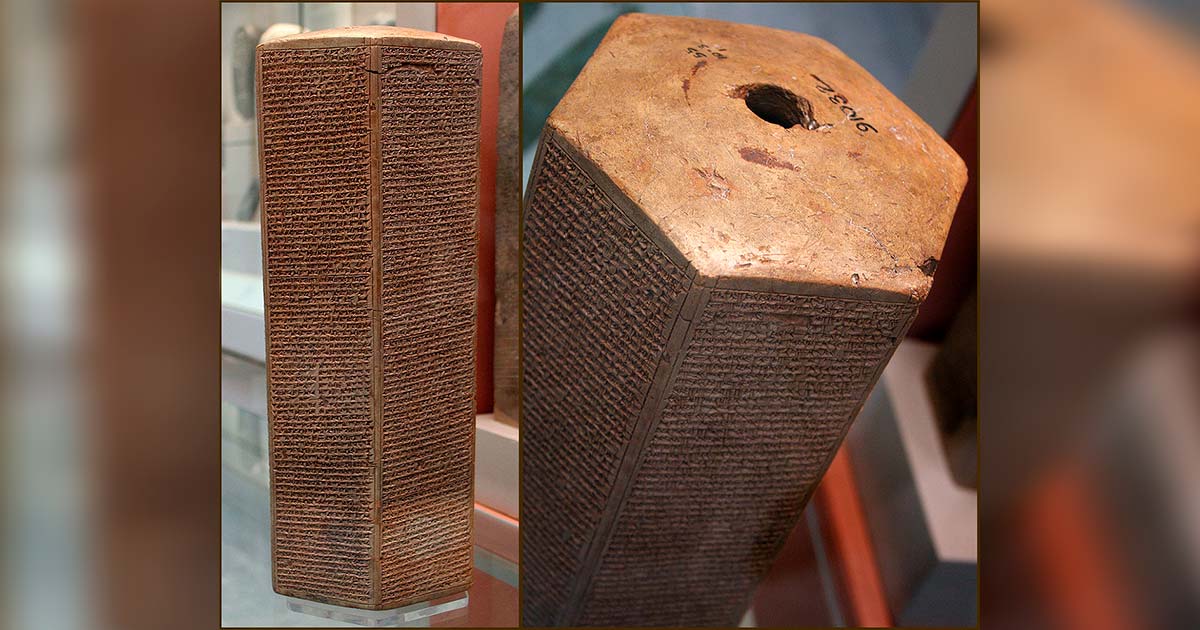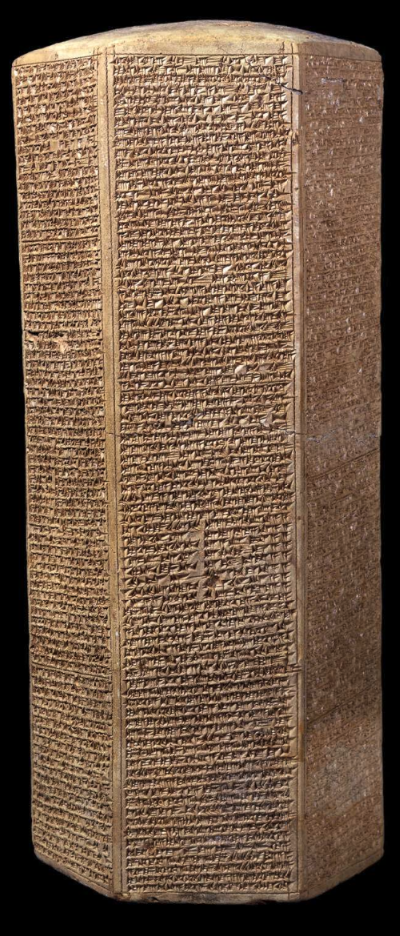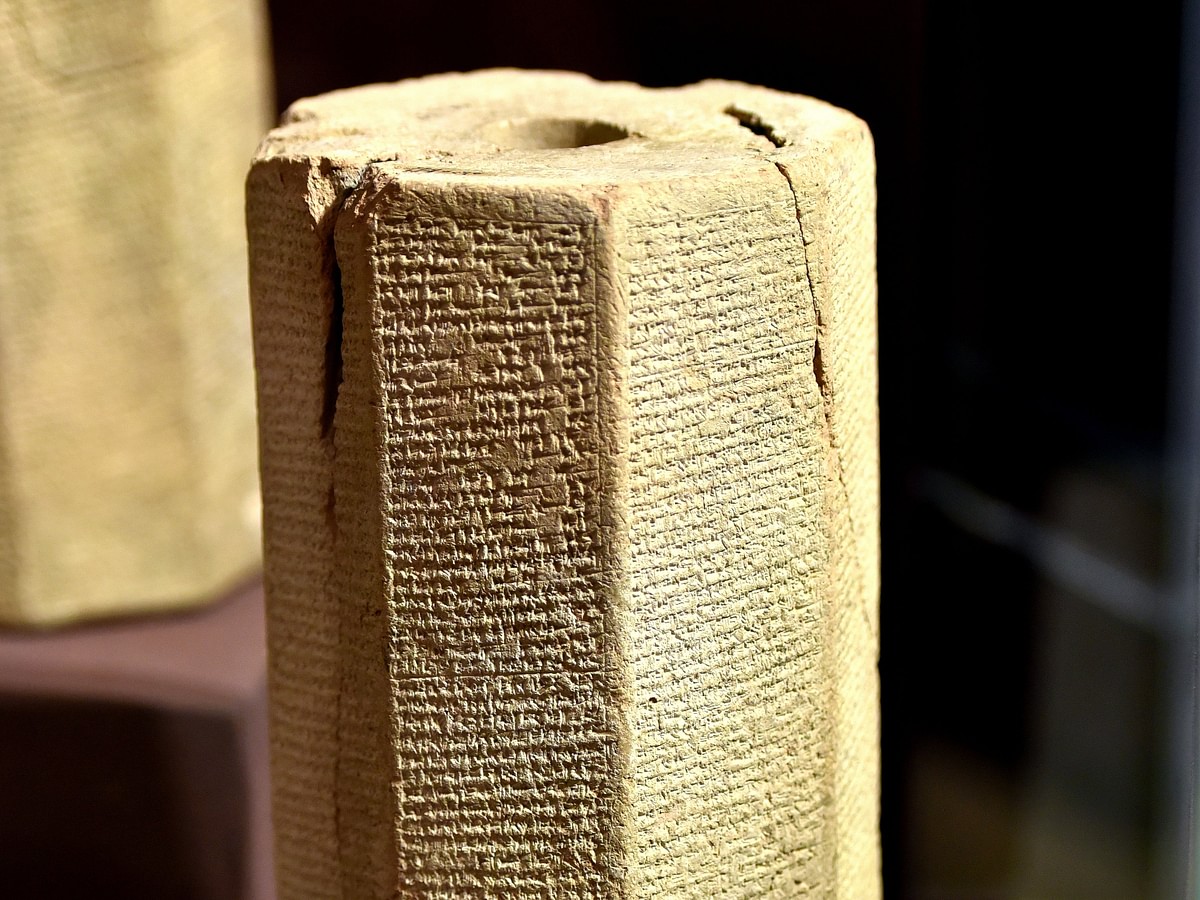Introduction
The ancient world is a tapestry of stories, each thread woven with the intricate histories of civilizations that have long since faded into the mists of time. Yet, every so often, a remarkable artifact emerges that sheds light on the past, offering us a glimpse into the lives and events that shaped the course of human history. The Sennacherib Prism, also known as the Taylor Prism, is one such artifact – a testament to the power and grandeur of the Neo-Assyrian Empire and the reign of its formidable ruler, King Sennacherib.

This baked clay prism, standing at a towering 38 centimeters (15 inches) in height, is a treasure trove of historical information, etched with cuneiform inscriptions that recount the military campaigns, architectural achievements, and political triumphs of Sennacherib’s reign from 705 to 681 BC. As we delve into the captivating narrative preserved within this ancient relic, we will uncover the significance of the Sennacherib Prism and its enduring impact on our understanding of the ancient Near East.
The Discovery and Acquisition of the Sennacherib Prism
The Sennacherib Prism was first discovered in the 1830s by British archaeologist Colonel Robert Taylor, who acquired the artifact and later donated it to the British Museum in London, where it is currently housed. The prism’s journey to the museum is a testament to the ongoing efforts of scholars and archaeologists to uncover and preserve the relics of the past, ensuring that they can continue to inform and educate generations to come.

The Sennacherib Prism’s impressive size and intricate cuneiform inscriptions immediately captured the attention of scholars and historians, who recognized its immense value as a primary source of information on the Neo-Assyrian Empire and the reign of King Sennacherib. The prism’s discovery was a significant milestone in the study of ancient Mesopotamian history, providing a rare and invaluable glimpse into the military exploits, architectural achievements, and political machinations of one of the most powerful empires of the ancient world.
The Cuneiform Inscriptions: A Detailed Account of Sennacherib’s Reign
The Sennacherib Prism is a remarkable artifact not only for its physical presence but also for the wealth of information it contains. The prism is covered in cuneiform inscriptions, the written script of ancient Mesopotamia, which provide a detailed account of Sennacherib’s military campaigns and conquests, particularly his invasion of the Kingdom of Judah and the siege of Jerusalem in 701 BC.
The inscriptions on the prism describe how Sennacherib launched a campaign against various cities in Judah, including the prominent cities of Lachish and Azekah. The text then recounts the siege of Jerusalem, detailing how Sennacherib captured numerous cities and deported their inhabitants. However, the prism notably omits any mention of the conquest of Jerusalem, suggesting that Sennacherib’s desired outcome in the city was not achieved.
The cuneiform inscriptions on the Sennacherib Prism also offer insights into the grandeur and power of the Neo-Assyrian Empire. The text boasts of Sennacherib’s vast wealth, his impressive architectural achievements, and the tribute he received from the various nations he conquered. This portrayal of Sennacherib as a powerful and victorious ruler reinforces the image of the Assyrian Empire as a formidable military and political force in the ancient Near East.
Corroborating Biblical Accounts
The Sennacherib Prism is not only a remarkable historical artifact in its own right but also a crucial piece of evidence that corroborates and expands upon the biblical accounts of Sennacherib’s reign. The events described on the prism, particularly the invasion of Judah and the siege of Jerusalem, find parallels in the Books of Kings and Chronicles in the Bible.

This cross-referencing of historical sources is invaluable for scholars and historians, as it allows them to piece together a more comprehensive understanding of the geopolitical landscape and military campaigns of the ancient Near East during the 8th century BC. The Sennacherib Prism provides an Assyrian perspective on these events, offering a unique and authoritative counterpoint to the biblical narratives.
The Significance of the Sennacherib Prism
The Sennacherib Prism is a significant historical document for several reasons. Firstly, it offers a rare and detailed account of the military exploits and political triumphs of the Neo-Assyrian Empire, providing a window into the power and ambition of one of the ancient world’s most formidable civilizations.
Secondly, the prism’s corroboration of biblical accounts lends credibility to these historical sources, reinforcing their value as important records of the ancient Near East. By cross-referencing the Sennacherib Prism with the Books of Kings and Chronicles, scholars can gain a more nuanced and comprehensive understanding of the events and power dynamics that shaped the region during this pivotal period.
Moreover, the Sennacherib Prism is a testament to the ongoing efforts of archaeologists and historians to uncover and preserve the relics of the past. The prism’s journey from its discovery in the 1830s to its current home at the British Museum is a testament to the dedication and perseverance of these scholars, who work tirelessly to ensure that the stories of the ancient world are not lost to time.
The Broader Context: The Neo-Assyrian Empire and Its Interactions
The Sennacherib Prism is not the only ancient artifact that sheds light on the Neo-Assyrian Empire and its interactions with neighboring kingdoms. Other important inscriptions, such as the Taylor Cylinder and the Jerusalem Prism, provide additional information and perspectives on Sennacherib’s reign and the Assyrian Empire’s broader geopolitical relationships.

These sources, when considered collectively, contribute to a more comprehensive understanding of the ancient Near East during this pivotal period. They offer insights into the power dynamics, diplomatic relationships, and military strategies that shaped the region, allowing us to better appreciate the complexities and nuances of this fascinating historical era.
Conclusion
The Sennacherib Prism stands as a testament to the enduring legacy of the Neo-Assyrian Empire and the remarkable achievements of its formidable ruler, King Sennacherib. This ancient artifact, with its captivating cuneiform inscriptions, provides a rare and invaluable glimpse into the military campaigns, architectural wonders, and political triumphs that defined Sennacherib’s reign.
As we delve into the rich history preserved within the Sennacherib Prism, we are reminded of the power of artifacts to bridge the gap between the past and the present, allowing us to better understand the complexities and intricacies of the ancient world. This prism, along with other related inscriptions, continues to shape our understanding of the ancient Near East, offering a window into the lives, events, and legacies that have shaped the course of human history.

